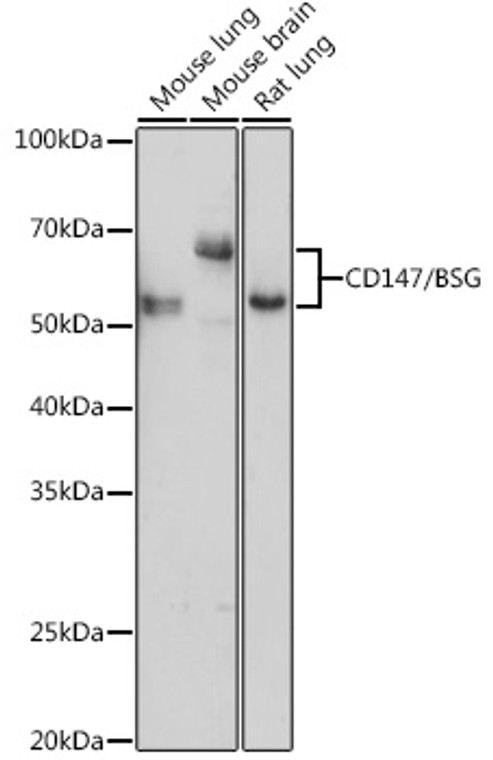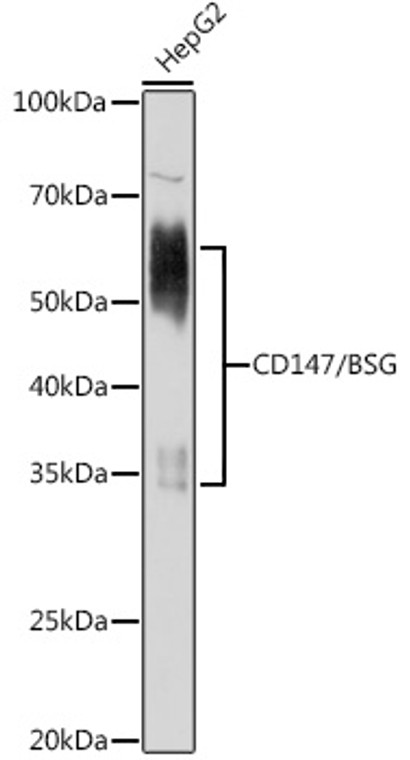| Host: |
Rabbit |
| Applications: |
WB |
| Reactivity: |
Human/Mouse/Rat |
| Note: |
STRICTLY FOR FURTHER SCIENTIFIC RESEARCH USE ONLY (RUO). MUST NOT TO BE USED IN DIAGNOSTIC OR THERAPEUTIC APPLICATIONS. |
| Short Description: |
Rabbit polyclonal antibody anti-BSG (286-385) is suitable for use in Western Blot research applications. |
| Clonality: |
Polyclonal |
| Conjugation: |
Unconjugated |
| Isotype: |
IgG |
| Formulation: |
PBS with 0.01% Thimerosal, 50% Glycerol, pH7.3. |
| Purification: |
Affinity purification |
| Dilution Range: |
WB 1:500-1:1000 |
| Storage Instruction: |
Store at-20°C for up to 1 year from the date of receipt, and avoid repeat freeze-thaw cycles. |
| Gene Symbol: |
BSG |
| Gene ID: |
682 |
| Uniprot ID: |
BASI_HUMAN |
| Immunogen Region: |
286-385 |
| Immunogen: |
A synthetic peptide corresponding to a sequence within amino acids 286-385 of human CD147/CD147/BSG (NP_001719.2). |
| Immunogen Sequence: |
HIENLNMEADPGQYRCNGTS SKGSDQAIITLRVRSHLAAL WPFLGIVAEVLVLVTIIFIY EKRRKPEDVLDDDDAGSAPL KSSGQHQNDKGKNVRQRNSS |
| Tissue Specificity | Isoform 1: Retina-specific. Expressed in retinal cone photoreceptors (at protein level). Isoform 2: Expressed in erythrocytes (at protein level). Highly expressed in melanoma cell lines (at protein level). Highly expressed in the heart, kidney, skeletal muscle and testis. Isoform 3: Highly expressed in the bone marrow, fetal liver, lung, testis and thymus. Isoform 4: Highly expressed in the bone marrow, fetal liver, lung, testis and thymus. |
| Post Translational Modifications | Isoform 2: N-glycosylated. Isoform 3: N-glycosylated. Isoform 4: N-glycosylated. |
| Function | Isoform 1: Essential for normal retinal maturation and development. Acts as a retinal cell surface receptor for NXNL1 and plays an important role in NXNL1-mediated survival of retinal cone photoreceptors. In association with glucose transporter SLC16A1/GLUT1 and NXNL1, promotes retinal cone survival by enhancing aerobic glycolysis and accelerating the entry of glucose into photoreceptors. May act as a potent stimulator of IL6 secretion in multiple cell lines that include monocytes. Isoform 1: (Microbial infection) Erythrocyte receptor for P.falciparum RH5 which is essential for erythrocyte invasion by the merozoite stage of P.falciparum isolates 3D7 and Dd2. Isoform 2: Signaling receptor for cyclophilins, essential for PPIA/CYPA and PPIB/CYPB-dependent signaling related to chemotaxis and adhesion of immune cells. Plays an important role in targeting monocarboxylate transporters SLC16A1/GLUT1, SLC16A11 and SLC16A12 to the plasma membrane. Acts as a coreceptor for vascular endothelial growth factor receptor 2 (KDR/VEGFR2) in endothelial cells enhancing its VEGFA-mediated activation and downstream signaling. Promotes angiogenesis through EPAS1/HIF2A-mediated up-regulation of VEGFA (isoform VEGF-165 and VEGF-121) and KDR/VEGFR2 in endothelial cells. Plays a key role in regulating tumor growth, invasion, metastasis and neoangiogenesis by stimulating the production and release of extracellular matrix metalloproteinases and KDR/VEGFR2 by both tumor cells and stromal cells (fibroblasts and endothelial cells). Isoform 2: (Microbial infection) Erythrocyte receptor for P.falciparum RH5 which is essential for erythrocyte invasion by the merozoite stage of P.falciparum isolates 3D7, Dd2, 7G8 and HB3. Binding of P.falciparum RH5 results in BSG dimerization which triggers an increase in intracellular Ca(2+) in the erythrocyte. This essential step leads to a rearrangement of the erythrocyte cytoskeleton required for the merozoite invasion. Isoform 2: (Microbial infection) Can facilitate human SARS coronavirus (SARS-CoV-1) infection via its interaction with virus-associated PPIA/CYPA. Isoform 2: (Microbial infection) Can facilitate HIV-1 infection via its interaction with virus-associated PPIA/CYPA. Isoform 2: (Microbial infection) First described as a receptor for severe acute respiratory syndrome coronavirus 2 (SARS-CoV-2), it is not required for SARS-CoV-2 infection. Isoform 2: (Microbial infection) Acts as a receptor for measles virus. Isoform 2: (Microbial infection) Promotes entry of pentamer-expressing human cytomegalovirus (HCMV) into epithelial and endothelial cells. |
| Protein Name | Basigin5f7Collagenase Stimulatory FactorExtracellular Matrix Metalloproteinase InducerEmmprinHepatoma-Associated AntigenHab18gLeukocyte Activation Antigen M6Ok Blood Group AntigenTumor Cell-Derived Collagenase Stimulatory FactorTcsfCd Antigen Cd147 |
| Database Links | Reactome: R-HSA-1474228Reactome: R-HSA-210991Reactome: R-HSA-216083Reactome: R-HSA-433692Reactome: R-HSA-5619070Reactome: R-HSA-70268Reactome: R-HSA-9749641 |
| Cellular Localisation | MelanosomeIdentified By Mass Spectrometry In Melanosome Fractions From Stage I To Stage IvIsoform 1: Cell MembraneSingle-Pass Type I Membrane ProteinPhotoreceptor Inner SegmentCell ProjectionCiliumPhotoreceptor Outer SegmentIsoform 2: Cell MembraneEndosomeEndoplasmic Reticulum MembraneBasolateral Cell MembraneIsoform 3: Cell MembraneIsoform 4: Cell Membrane |
| Alternative Antibody Names | Anti-Basigin antibodyAnti-5f7 antibodyAnti-Collagenase Stimulatory Factor antibodyAnti-Extracellular Matrix Metalloproteinase Inducer antibodyAnti-Emmprin antibodyAnti-Hepatoma-Associated Antigen antibodyAnti-Hab18g antibodyAnti-Leukocyte Activation Antigen M6 antibodyAnti-Ok Blood Group Antigen antibodyAnti-Tumor Cell-Derived Collagenase Stimulatory Factor antibodyAnti-Tcsf antibodyAnti-Cd Antigen Cd147 antibodyAnti-BSG antibodyAnti-UNQ6505 antibodyAnti-PRO21383 antibody |
Information sourced from Uniprot.org
12 months for antibodies. 6 months for ELISA Kits. Please see website T&Cs for further guidance









